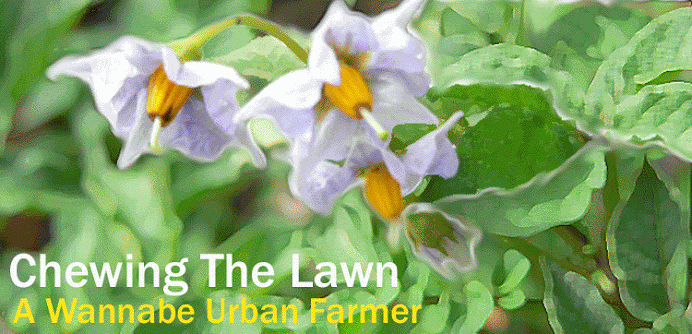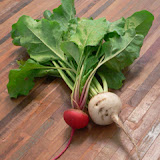Friday, April 10, 2009
Damping off of peas
Looks like definitely one maybe two of my Lincoln pea seedlings now has damping off. Research is showing most likely I was keeping them too wet in the beginning. Is frustrating since these were directly seeded into the ground unlike the others which were transplants.
Things to do next time:
1. Less water
2. Thin layer of sand
3. Do not keep seedlings in humidity as long after sprouting
4. Do not water at night.
Thursday, April 9, 2009
Potato Instructions
Instructions for the Potato Bin
 |
| The Potato Bin in our display gardens in Burlington, VT, just a few weeks before harvest. |
We grew potatoes in a number of different fabric pots, and this one came out the winner, producing a big, 13 pound harvest. The porous fabric of the Potato Bag aerates roots, prevents heat build-up and allows excess water to drain away. Its compact size lets you grow your own potatoes in just about any sunny spot.
Potato Basics1. Use certified seed potatoes
You’ll get best results if you use certified seed potatoes, such as our Flowering Potatoes. There are hundreds of varieties of potatoes available, varying greatly in fl avor, shape and length of growing season.
Most potato plants require 65 to 100 days to grow, mature and develop full size spuds. Early varieties that thrive in cool weather can be planted in the spring about two weeks before the last hard frost.
2. Cutting seed pieces
Some potato growers cut seed potatoes into chunks as they plant and others cut them a few days before planting and let the cut surfaces callous over. Either method works well. Each piece should weigh approximately 1-1/2 to 2 ounces with no less than 2 to 3 eyes (sprouts) per piece. Small seed potatoes may be planted whole.
3. Preparing the Soil
Potatoes prefer a rich loam soil with a pH of about 6.0. If you’re not sure of your soil’s fertility, take a soil test to measure the N-P-K levels. If your soil needs fertilizer, we recommend our All-Purpose Fertilizer. Follow the application instructions provided. At mid-season, if the leaves are slightly yellow or the plants are not growing well, add more fertilizer.
4. Planting seed potatoes
Avoid planting potatoes too early in cold, wet soil. Let the soil warm to above 45 degrees F.
5. Watering and Irrigation
Growing tubers need regular and consistent watering. Keep the soil damp, but not soggy. The amount of rainfall you receive will affect how often you need to water. Typically, 1 inch of rainfall per week is sufficient. You can use a rain gauge to keep close watch. It’s important you don’t over-water the Potato Bag. This could result in rotting tubers. However, not watering enough will reduce your potato yield. If you live in a region with very hot summer weather, you may need to provide partial shade or position your Potato Bag where it will be shielded from intense heat.
6. Pests and diseases
Most pests and diseases can be prevented with healthy soil and consistent watering. If your plants do become infected with a disease, replace the soil in the bag before planting the following year. Add a humus-rich compost to discourage the disease from returning. Identify the insects in your garden. Become familiar with insects that are beneficial and those that are pests. Common potato pests such as Colorado potato beetle and potato leafhopper can be removed by hand or controlled with repeated use of an insecticidal soap.
Don’t forget to check the undersides of leaves! Persistent observation and removal is the key to pest control.
Planting Instructions
Step 1. Two days prior to planting, cut seed potatoes into pieces with at least two or three eyes each and allow them to callous over.
Step 2. Combine 1/2 garden soil with 1/2 compost and fill the Potato Bag about 1/3 full.
Step 3. Plant five seed potatoes in the soil and compost mixture, evenly spaced.
Step 4. Water the soil until it is consistently moist throughout, not soggy.
Step 5. As the potato seeds grow stems, mound more soil/compost mixture on top of them, making sure not to cover too many leaves—the leaves need exposure to air and sun to make the plant’s food.
Step 6. As potato stems and leaves continue to grow, keep adding the soil/compost mixture until eventually reaching the top of the bag.
 |
| This Potato Bin is ready for harvest. |
Step 7. The potato leaves and stems will start to turn yellow toward the end of the summer and into the fall. (Exact timing depends on the potato variety and what zone you are growing in.) When cooler weather settles in and the foliage has died back, stop watering completely about two weeks prior to harvest. When the potato plant leaves turn almost completely yellow, the potatoes are ready for harvesting.
Step 8. To harvest, pull out all of the stems and leaves. To prevent cutting the potato flesh, use your hand instead of a trowel to carefully dig around in the soil to find the hidden potatoes.
Step 9. Spread the potatoes out in a single layer to dry for a day or so. Then you can easily brush the soil off and the potatoes will be ready for storage. Store the potatoes a cool, dry place, with good ventilation.
Step 10. Empty the Potato Bag and allow it to dry. Brush away any dried soil, fold, and store the bag in a dry location until next spring.
Wednesday, April 8, 2009
Aphids attack
Discovered aphids today on the broccoli and small greens specifically the spinach so far. Have also been fighting imported cabbageworm butterflies. I have been combing the plants for the eggs they lay will treat with BT tomorrow. Bought lady bugs to release tonight.
Set up potato bags today. I mixed
• one bag Hu Max
• One bag compost
• 1/4 bag expanded shale
• 3 scoops green sand
• 1/2 scoop molasses
• 1 tsp per potato north haven garden fertilizer
Planted 7 potatoes per bag French fingerling and blue
Planted 5 potatoes per bag Yukon
Worried about Yukon since did not get 2-3 eyes per potato
Planted following seeds
1. Squash straightneck
2. Vegetable spaghetti
3. New england sugar pie
4. Zucchini rampicante
5. Butternut Waltham
6. Watermelon sugar baby
7. Honey rock melon (last seeds did not sprout)
8. Sweet corn country gentleman
9. Boston pickling
10. Lemon cucumber
11. Okra
12. Yellow wonder strawberries
I think I had problems with damping off on many of the seedlings that fell over and had weak stems especially cukes, watermelon, and some squash.
Tomatoes are having problems with the leaves turning yellow and drying out. I need to research this problem.
Sunday, April 5, 2009
Broccoli bolting cucumber mass suicide
The broccoli I bought that already had a head on it bolted when warm spring weather got here this week. Need to remember not to pick cold crops with head already. Also need to remenber to pick ones that the stem is short and close to the earth. The tall stemmed ones I bought seem to be struggling with the wind.

Picture of bolted broccoli
Discovered both the cucumber plants dead Saturday morning the stems had fallen over in half not too suprisimg since they had lost all their leaves. When I pulled them up found baby slugs on the roots will reapply sluggo tomorrow. Squash plants seem to be struggling with too long a stem and losing their leaves since the wind has been merciless lately. I plan to remove them tomorrow. I will reseed both the cucumbers and squash tomorrow morning. I am switching the location of the cucumbers, so the okra is in between them to try and prevent cross polination. Next year I do not need to start squash or cucumbers for transplant instead seed them directly.
I sprayed liquid tea and sea fertilizer tonight.

